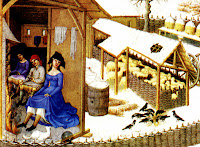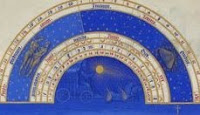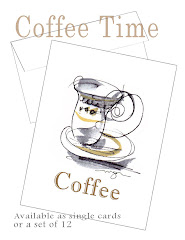
You probably got at least one calendar over the holidays, no doubt with beautiful pictures and a handy way to keep track of dates and events. (I received two, one made by my husband

with his own wonderful photographs.) This is not a new idea; the European Middle Ages was a high point for pretty, well-organized calendars - known then as Books of Hours. Religion, of course, was the prompt - Christianity dominated art and culture at the time - but once you take that for granted and keep going, you find the most fascinating details about time, place, and people. Life then was lived by the seasons; people timed their activities by a natural clock of growth and survival accented by festivals celebrating milestones of the year. You can find the labors of the months all over the place once you start looking - carved into cathedrals, formed into stained glass windows, and - in Books of Hours, painstakingly painted with tiny brushes and jewel-like colors on vellum pages. The most famous Book of Hours is the exquisite "Les Tres Belles Heures du Duc du Berry" from the early 15th century, painted by the Limbourg Brothers. A Book of Hours is not meant to be a calendar in the

modern sense of the word; the purpose is to track the hours of prayer so that a lay person can follow a private schedule of devotion,

but the Duc de Berry's version gives a vivid calendar of the months as well as a delightfully detailed look at contemporary events, styles, and lives at the upper and lower levels of society. The page at the upper left is January, when the wealthy and privileged distributed gifts to the working class and the poor. The Duc (unbelievably wealthy, incredibly important politically and socially, with multiple palaces, many of which are shown in these pages) sits at a banquet with his entourage, enjoying the bounty of his life. On the right is February, when the Duc's workers huddle down to wait out the winter until labors of the land pick up again. The enlargement reveals one of the most amusing details - the men hike up their tunics to warm their .... while the woman looks modestly away. The other month shown here is May; planting

is well underway. Note the careful, well-tended look to the landscape (with one of the Duc's palaces in the background) - it trumpets the tidy health and well-being of the Duc's estates, but also signifies God's order in the world of men. The top of each page is a kind of almanac with the movement of the heavens and, in some cases, the signs of the zodiac. Delightful - but not cheap. Only the wealthy could commission such extraordinary works - no bargain "2 for $10" calendars in the Middle Ages!
 You probably got at least one calendar over the holidays, no doubt with beautiful pictures and a handy way to keep track of dates and events. (I received two, one made by my husband
You probably got at least one calendar over the holidays, no doubt with beautiful pictures and a handy way to keep track of dates and events. (I received two, one made by my husband  with his own wonderful photographs.) This is not a new idea; the European Middle Ages was a high point for pretty, well-organized calendars - known then as Books of Hours. Religion, of course, was the prompt - Christianity dominated art and culture at the time - but once you take that for granted and keep going, you find the most fascinating details about time, place, and people. Life then was lived by the seasons; people timed their activities by a natural clock of growth and survival accented by festivals celebrating milestones of the year. You can find the labors of the months all over the place once you start looking - carved into cathedrals, formed into stained glass windows, and - in Books of Hours, painstakingly painted with tiny brushes and jewel-like colors on vellum pages. The most famous Book of Hours is the exquisite "Les Tres Belles Heures du Duc du Berry" from the early 15th century, painted by the Limbourg Brothers. A Book of Hours is not meant to be a calendar in the
with his own wonderful photographs.) This is not a new idea; the European Middle Ages was a high point for pretty, well-organized calendars - known then as Books of Hours. Religion, of course, was the prompt - Christianity dominated art and culture at the time - but once you take that for granted and keep going, you find the most fascinating details about time, place, and people. Life then was lived by the seasons; people timed their activities by a natural clock of growth and survival accented by festivals celebrating milestones of the year. You can find the labors of the months all over the place once you start looking - carved into cathedrals, formed into stained glass windows, and - in Books of Hours, painstakingly painted with tiny brushes and jewel-like colors on vellum pages. The most famous Book of Hours is the exquisite "Les Tres Belles Heures du Duc du Berry" from the early 15th century, painted by the Limbourg Brothers. A Book of Hours is not meant to be a calendar in the  modern sense of the word; the purpose is to track the hours of prayer so that a lay person can follow a private schedule of devotion,
modern sense of the word; the purpose is to track the hours of prayer so that a lay person can follow a private schedule of devotion,  but the Duc de Berry's version gives a vivid calendar of the months as well as a delightfully detailed look at contemporary events, styles, and lives at the upper and lower levels of society. The page at the upper left is January, when the wealthy and privileged distributed gifts to the working class and the poor. The Duc (unbelievably wealthy, incredibly important politically and socially, with multiple palaces, many of which are shown in these pages) sits at a banquet with his entourage, enjoying the bounty of his life. On the right is February, when the Duc's workers huddle down to wait out the winter until labors of the land pick up again. The enlargement reveals one of the most amusing details - the men hike up their tunics to warm their .... while the woman looks modestly away. The other month shown here is May; planting
but the Duc de Berry's version gives a vivid calendar of the months as well as a delightfully detailed look at contemporary events, styles, and lives at the upper and lower levels of society. The page at the upper left is January, when the wealthy and privileged distributed gifts to the working class and the poor. The Duc (unbelievably wealthy, incredibly important politically and socially, with multiple palaces, many of which are shown in these pages) sits at a banquet with his entourage, enjoying the bounty of his life. On the right is February, when the Duc's workers huddle down to wait out the winter until labors of the land pick up again. The enlargement reveals one of the most amusing details - the men hike up their tunics to warm their .... while the woman looks modestly away. The other month shown here is May; planting  is well underway. Note the careful, well-tended look to the landscape (with one of the Duc's palaces in the background) - it trumpets the tidy health and well-being of the Duc's estates, but also signifies God's order in the world of men. The top of each page is a kind of almanac with the movement of the heavens and, in some cases, the signs of the zodiac. Delightful - but not cheap. Only the wealthy could commission such extraordinary works - no bargain "2 for $10" calendars in the Middle Ages!
is well underway. Note the careful, well-tended look to the landscape (with one of the Duc's palaces in the background) - it trumpets the tidy health and well-being of the Duc's estates, but also signifies God's order in the world of men. The top of each page is a kind of almanac with the movement of the heavens and, in some cases, the signs of the zodiac. Delightful - but not cheap. Only the wealthy could commission such extraordinary works - no bargain "2 for $10" calendars in the Middle Ages!


